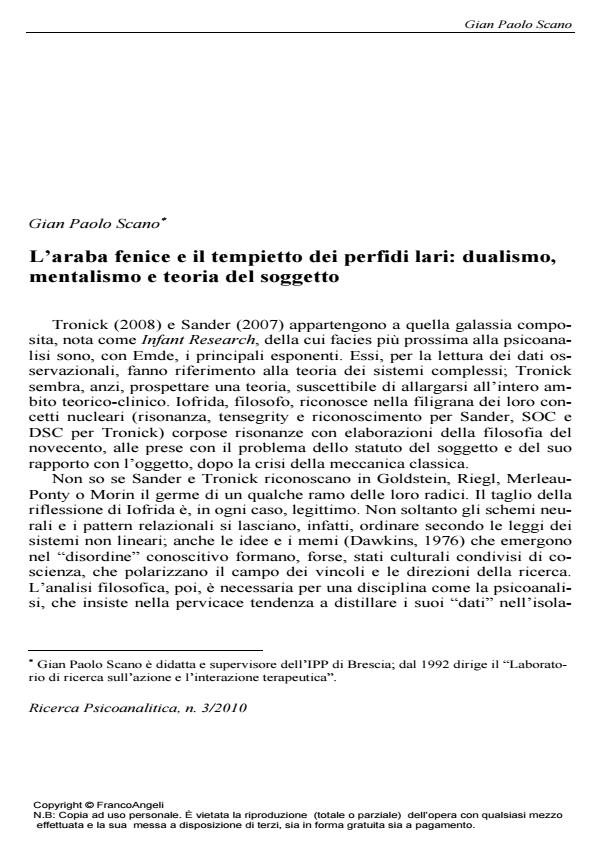L’araba fenice e il tempietto dei perfidi lari: dualismo, mentalismo e teoria del soggetto
Titolo Rivista RICERCA PSICOANALITICA
Autori/Curatori Gian Paolo Scano
Anno di pubblicazione 2010 Fascicolo 2010/3
Lingua Italiano Numero pagine 20 P. 77-96 Dimensione file 516 KB
DOI 10.3280/RPR2010-003006
Il DOI è il codice a barre della proprietà intellettuale: per saperne di più
clicca qui
Qui sotto puoi vedere in anteprima la prima pagina di questo articolo.
Se questo articolo ti interessa, lo puoi acquistare (e scaricare in formato pdf) seguendo le facili indicazioni per acquistare il download credit. Acquista Download Credits per scaricare questo Articolo in formato PDF

FrancoAngeli è membro della Publishers International Linking Association, Inc (PILA)associazione indipendente e non profit per facilitare (attraverso i servizi tecnologici implementati da CrossRef.org) l’accesso degli studiosi ai contenuti digitali nelle pubblicazioni professionali e scientifiche
La psicoanalisi nacque come disciplina fisicalista agli albori della crisi della meccanica classica, che ha lasciato la sua impronta sia nella teoria, che rivela un imprevisto dualismo nell’impianto meccanicista, che nella sua evoluzione storica, schiacciata tra contrapposte istanze riduzioniste e mentalista tuttora perduranti. È difficile dire se la teoria dei sistemi sia sufficiente antidoto contro ogni ritorno del mentalismo, che facilmente filtra nel linguaggio teorico tramite radicate abitudini e pregiudizi, che, come gli idola theatri di F. Bacon, intralciano i processi della conoscenza. L’A. evidenzia alcuni di tali idoli pregiudiziali, riconducendoli ad un’insufficiente considerazione della prospettiva evoluzionista nell’ambito della teoresi psicologica. A partire dall’assunto che il cervello deve essere considerato, anche nelle sue caratteristiche alte e nella sua natura di cervello-che-costruisce-unamente, come un effetto casuale della storia degli organismi di questo pianeta, egli delimita una piattaforma, che poggiando sul ruolo dei qualia nel mondo effettivo della selezione naturale, potrebbe affrontare il problema dell’Io, della soggettività e dell’intersoggettività in termini dichiaratamente evoluzionisti in grado di integrare, nella prima, la "natura seconda". Questa prospettiva, tuttavia appena abbozzata, sembra poter consentire di evitare, tanto la Scilla riduzionista quanto la Cariddi mentalista.
Parole chiave:Dualismo, mentalismo, qualia, teoria del soggetto, Io
Gian Paolo Scano, L’araba fenice e il tempietto dei perfidi lari: dualismo, mentalismo e teoria del soggetto in "RICERCA PSICOANALITICA" 3/2010, pp 77-96, DOI: 10.3280/RPR2010-003006